What Approach to Flemish Annunciations?
Abstract
:1. Introduction
2. What Approach to Flemish Annunciations?
2.1. Mirroring Devotion: Flemish Annunciations as Historical Sources
2.1.1. The Space(s), the Objects and the Bodily Attitudes of Devotion
2.1.2. A Reflection of the Materiality of Domestic Devotion?
2.2. An Artistic Tradition: Flemish Annunciations as Artworks
2.2.1. The Annunciation in the Bedroom by Rogier van der Weyden: Its Artistic Sources and Influence
2.2.2. The Annunciation in the Bedroom by Joos van Cleve: Artistic Citation and Archaism
2.3. Supporting Devotion: Flemish Annunciations as Devotional Objects
2.3.1. Staging Devotion: Devotional Portraits and Models of Devotion
2.3.2. Guiding Devotion: The Structuring of Pictorial Space
3. Conclusions
Funding
Institutional Review Board Statement
Informed Consent Statement
Data Availability Statement
Conflicts of Interest
| 1 | The correspondence between what the Tournaisian archives tell us of the life and work of Robert Campin and his workshop, and the consideration of the works attributed to the Master of Flémalle in their chronology and quality, seems close enough to suggest the identification of the two figures. However, the debate is still on-going (Campbell 1974, p. 646). |
| 2 | However, against David Robb’s assertion, the Merode Altarpiece is not the first example of a ‘unified’ interior (Robb 1936, pp. 503–4). The Merode Altarpiece depends in fact on an existing model and achieves this unification of space only in a very imperfect manner. For the sake of convenience, I take the Merode Altarpiece as the starting point for my reflection, given the fortune of this work in the historiography of fifteenth-century Flemish painting. Furthermore, it is important to specify that, even if the domestic setting was predominant, other iconographical types of the Annunciation (for example in the church) existed in Flemish painting. |
| 3 | (Panofsky 1966, p. 254): “Where a bed appears in such contemporary or slightly earlier renderings as the Brenken altarpiece or the ‘Annunciations’ by Masolino, Fra Angelico and Bicci di Lorenzo it is removed into an alcove in the rear or nearly hidden in an adjacent room, a modest footnote to the main text”. |
| 4 | In this respect, it is the composition on the left-hand panel of the Saint Columba Altarpiece, also by Rogier van der Weyden, rather than that of the Louvre, that seems to have had the greater impact at least in the second half of the fifteenth century, as the numerous existing copies and variations demonstrate. However, this is beyond the scope of this essay. |
| 5 | Technical and stylistic analyses of the Merode Altarpiece have demonstrated that the triptych was created in several stages following the wishes of the man portrayed on the left wing. After he had commissioned or chosen the Annunciation panel among the available products of the workshop, the man had himself portrayed on the left wing while he was still single, asking the Virgin to intercede in favour of his marriage. Then, once married, he had his wife added to the left-hand panel (Kemperdick 1997, p. 85). Scholars have proposed several hypotheses about the identity of the figures portrayed on the left wing, based on the coats of arms painted on the centre panel although they cannot be identified with certainty. However, the male sitter is probably Peter Engelbrecht, a merchant from Cologne who had relatives in Mechelen, and the female sitter might be Peter’s first wife, Gretgin Schrinmecher, whom he married between 1425 and 1428 (Installé 1992, p. 80; Kemperdick 1997, p. 87). |
| 6 | In Here Begins a Devout Book on the Preparation and Decoration of the Dwelling of Our Heart, Hendrik Mande (1350/60–1431) invites the reader to take a tour of his own house and describes in great detail a series of ordinary domestic objects, which are allegories of the virtues of the soul and are related to each other according to the technique of the arts of memory (Mande 1854). |
| 7 | (Falkenburg 2001, p. 4): “Images were integral parts of this culture, as much as texts were; each medium sustained and affected the other in its capacity to support prayer, meditation, and other devotional practices”. |
| 8 | (Falkenburg 2001, p. 7): “These symbols are not (disguised) abstract notions, but the ‘embodiments’ of the properties of Mary’s soul that—similar to the effect of Mande’s text—serve as prototypes for the viewer to shape his inner self while meditating on the image. If the spectator scrutinizes the interior of the house of Mary’s soul, halting at each object and article of furniture—the candle, flowers, pitcher and towel, and the bench against which Mary reclines—and ponders their symbolic meanings (for example, Mary’s purity and humility, or the references to redemption), he appropriates these connotations and decorates the house of his own soul with the same virtues that adorn Mary’s”. Falkenburg speaks of a pattern of ‘conformity’ (conformitas, mede-vormigheit) to interpret the visual strategies by which the patrons are invited to ‘conform’ their souls to that of Mary (Falkenburg 2001, p. 10). |
| 9 | In general, when scholarship has made use of paintings, it has been mostly content with documenting domestic interiors either from the perspective of material culture (Praz 1964; Thornton 1991; Ajmar-Wollheim and Dennis 2006; Ajmar-Wollheim et al. 2007) or from that of cultural history with the aim of uncovering the ideal of domestic sphere conveyed by these imaginary visions (Aynsley and Grant 2006, p. 12). Moreover, it has focused mainly respectively on the Italian Renaissance and the Dutch Golden Age. Strikingly, scholarship on domestic devotion has either left aside panel paintings or not made systematic use of them (Brundin et al. 2018; Corry et al. 2018). |
| 10 | The Brussels panel was long believed to be a copy after the Merode Altarpiece (Von Tschudi 1898, pp. 8–34, 89–116; Winkler 1913, p. 11; Gottlieb 1957). On the basis of infrared reflectography and stylistic criteria, Carla Gottlieb attributed the work to the painter Jacques Daret, who was an apprentice in the workshop of Robert Campin. The first art historian to propose an alternative thesis was Musper, who considered the Brussels version as the model for the Merode Altarpiece, which it surpassed in terms of artistic quality (Musper 1968, p. 62). Since then, the comparative technical analysis of the two paintings has confirmed the theory of the primacy of the Brussels version over that of New York. Jeltje Dijkstra’s study of the underdrawing indeed showed that the Merode Altarpiece follows the painted surface of the Brussels panel, thus making the latter the direct model for the former (Dijkstra 1996, pp. 96–99). |
| 11 | The Tournaisian wills are a very rich source concerning the possession of devotional objects. These documents, previously kept in the collection of chirographs of the municipal archives of Tournai, disappeared in May 1940 when the archive building burned down. But fortunately for us a local scholar, Amaury de La Grange, published in 1897 more than 1200 wills dating from the thirteenth to the fifteenth century (La Grange 1897). However, this is a selection and not the totality of the available documents. A chapter of my dissertation currently in preparation is devoted to the analysis of these wills from the point of view of the material culture of devotion. |
| 12 | The spatial indications given by the testators always concern the ‘room’ (chambre, cambre)—I have found eight mentions for the first half of the fifteenth century—that is a room in the house without any assigned function and which does not specifically designate the place where one sleeps, but which is neither the kitchen nor the hall or a semi-public space (salle) of the house. The place of devotion is, therefore, always a more or less intimate space. For instance, Maigne Crespelaines bequeaths a statue of the Virgin “qui est en la cambre par terre de [m]a maison“ (n°744), Marguerite le Ruddre donates an altar with statues “qui est en le chambre après le salle“ (n°761) and Jacques Croquevillain and Catherine de Saint Marcel give an altar “à tout ung Repos de Jhésus, qui est en [nostre] première cambre hault, dessus ung escring“ (n°707). |
| 13 | (Morse 2007, p. 170): “In most cases, altars were not located in discrete rooms that we could call a chapel, but were situated in the normal spaces of the casa (…)”. |
| 14 | Erwin Panofsky’s iconological analysis of Jan van Eyck’s paintings is based on the typological associations specific to medieval hermeneutics. The use of Romanesque and Gothic architectural elements and the imaginary combination of brilliantly imitated styles imply that every detail potentially had a symbolic meaning (Panofsky 1966, pp. 131–48). |
| 15 | Stephan Kemperdick bases himself on the engraving of Saint Christopher to propose a date for the panel. Similar examples are dated between 1420 and 1430 (one in Manchester even bears an exact date: 1423), which indicates that the work cannot have been created before the 1420s (Kemperdick 1997, p. 88). |
| 16 | (Lüken 2000, p. 296): “Das Gemach der Maria ist so eingerichtet oder ausgestattet, wie es sich für eine zukünftige Gottesmutter und Himmelskönigin gehörte: mit dem Besten und Neuesten. Die dargestellten Gegenstände waren den Betrachtern in der Regel bekannt, wenn auch in einer anderen Qualitätsstufe. Die Situation entsprach damit einem Ideal, mit dem sich die meisten Betrachter identifizieren konnten”. |
| 17 | The study of the underdrawing shows some changes in the composition indicating a creative process. Notably, Rogier added the cabinet and consequently shifted the window to the left (De Vos 1999, p. 195). |
| 18 | This ‘realistic’ aspect contrasts with the Annunciation of the Saint Columba Altarpiece, where the angel is given back his staff and Mary her halo, and the words of the Angelic Salutation are painted in golden letters (De Vos 1999, p. 195). |
| 19 | Or is it, as Maryan Ainsworth argues, because the painting aims at promoting “Catholic devotional practice at a time when Protestant Reformers were questioning the validity of imagery for religious worship?” (Ainsworth 2018). The specific problems entailed by the context of the Reformation exceed the scope of this article. |
| 20 | Panofsky sees the ‘Archaism of around 1500’ as a phenomenon limited to the Southern Netherlands and not affecting painters from Holland such as Lucas van Leyden and Jan van Scorel “because they did not need to free themselves from Rogier van der Weyden”. According to him, this marks the divide between Dutch and Flemish painting (Panofsky 1966, p. 356). |
| 21 | Ingrid Falque adopts this terminology for its broader scope than that of ‘donor portraits’ or ‘patrons’ (Falque 2019, pp. 4–6). |
| 22 | According to a tradition dating back to Saint Ambrose of Milan in his Expositio evangelii secundum Lucam (ca. 387), Mary was reading the prophecy of Isaiah foretelling the Incarnation (7:14: Ecce virgo concipiet, et pariet filium) upon the arrival of the Angel (Saetveit Miles 2014, p. 640). |
| 23 | According to De Coo, the motivations behind the acquisition of the painting exclude that it may have been intended for a church, even in the case of a family chapel in the aisle. (De Coo 1981, p. 131): “No couple was willing to acknowledge its own infertility and the publicity of portraits on an altarpiece set up in public will certainly have been avoided”. |
| 24 | (Drummond 2018, pp. 98–100): “Images of the Annunciation, announcing the actual moment of conception, were sometimes used as votive panels for couples who wished to have children, and Annunciation scenes were commonly hung in ‘lying-in’ hospitals throughout the Middle Ages”. |
| 25 | Although the original location of the triptych is not known with certainty, we know that Maria’s parents and her son Jan were buried close to St. Barbara’s altar in the Brussels Cathedral of Sts. Michael and Gudula. It is therefore likely that the graves of Maria and Simon, along with the triptych, were also located there (Stroo et al. 2006, p. 123). |
| 26 | (Falque 2019): The author combines a comparative analysis between spiritual texts and images as well as a visual analysis of the pictorial strategies used to guide meditation. She brings out several themes that are transversal between devotional literature and paintings, such as that of the spiritual journey. |
| 27 | The analysis of this corpus of paintings is the object of a chapter of my dissertation, which is currently in preparation. |
References
- Ainsworth, Maryan W. 2018. Catalogue Entry: The Annunciation by Joos van Cleve. Available online: https://www.metmuseum.org/art/collection/search/436791?searchField=All&sortBy=Relevance&ft=joos+van+cleve&offset=0&rpp=20&pos=4 (accessed on 30 October 2021).
- Ajmar-Wollheim, Marta, Flora Dennis, and Ann Matchette. 2007. Approaching the Italian Renaissance Interior: Sources, Methodologies, Debates. Malden: Blackwell. [Google Scholar]
- Ajmar-Wollheim, Marta, and Flora Dennis. 2006. At Home in Renaissance Italy. London: Victoria and Albert Museum. [Google Scholar]
- Aynsley, Jeremy, and Charlotte Grant. 2006. Imagined Interiors: Representing the Domestic Interior Since the Renaissance. South Kensington: V&A Publications. [Google Scholar]
- Baschet, Jérôme. 1996. Inventivité et sérialité des images médiévales. Pour une approche iconographique élargie. Annales. Histoire, Sciences Sociales 51: 93–133. [Google Scholar] [CrossRef]
- Baschet, Jérôme. 2008. L’iconographie Médiévale. Paris: Gallimard. [Google Scholar]
- Belting, Hans. 1990. Bild und Kult. Eine Geschichte des Bildes vor dem Zeitalter der Kunst. München: C.H. Beck. [Google Scholar]
- Brundin, Abigail, Deborah Howard, and Mary Laven. 2018. The Sacred Home in Renaissance Italy. Oxford: Oxford University Press. [Google Scholar]
- Campbell, Lorne. 1974. Robert Campin, the Master of Flémalle and the Master of Mérode. Burlington Magazine 116: 634–46. [Google Scholar]
- Corry, Maya, Marco Faini, and Alessia Meneghin. 2018. Domestic Devotions in Early Modern Italy. Leiden: Brill. [Google Scholar]
- De Coo, Jozef. 1981. A Medieval Look at the Merode Annunciation. Zeitschrift für Kunstgeschichte 44: 114–32. [Google Scholar] [CrossRef]
- De Vos, Dirk. 1999. Rogier van der Weyden. The Complete Works. Antwerp and New York: Mercatorfonds-Harry N. Abrams. [Google Scholar]
- Dijkstra, Jeltje. 1996. The Brussels and the Mérode Annunciation Reconsidered. In Robert Campin. New Directions in Scholarship. Edited by Susan Foister and Susie Nash. Turnhout: Brepols, pp. 95–104. [Google Scholar]
- Drummond, Sarah. 2018. Divine Conception. The Art of the Annunciation. London: Unicorn. [Google Scholar]
- Eichberger, Dagmar. 1998. Devotional Objects in Book Format: Diptychs in the Collection of Margaret of Austria and Her Family. In The Art of the Book: Its Place in Medieval Worship. Edited by Margaret M. Manion and Bernard J. Muir. Exeter: University of Exeter, pp. 291–323. [Google Scholar]
- Eichberger, Dagmar. 2003. A noble residence for a female regent: Margaret of Austria and the ’Court of Savoy’ in Mechelen. In Architecture and the Politics of Gender in Early Modern Europe. Edited by Helen Hills. Aldershot: Ashgate, pp. 25–46. [Google Scholar]
- Falkenburg, Reindert. 2001. The Household of the Soul: Conformity in the ‘Merode Triptych’. In Early Netherlandish Painting at the Crossroads. A Critical Look at Current Methodologies. Edited by Maryan W. Ainsworth. New York: Metropolitan Museum of Art, pp. 2–17. [Google Scholar]
- Falque, Ingrid. 2019. Devotional Portraiture and Spiritual Experience in Early Netherlandish Painting. Leiden and Boston: Brill. [Google Scholar]
- Gottlieb, Carla. 1957. The Brussels Version of the Mérode Annunciation. The Art Bulletin 39: 53–60. [Google Scholar] [CrossRef]
- Hahn, Cynthia. 1986. ‘Joseph Will Perfect, Mary Enlighten and Jesus Save Thee:’ The Holy Family as Marriage Model in the Mérode Triptych. The Art Bulletin 68: 54–66. [Google Scholar]
- Harbison, Craig. 1984. Realism and Symbolism in Early Flemish Painting. The Art Bulletin 66: 588–602. [Google Scholar] [CrossRef]
- Harbison, Craig. 1985. Visions and Meditations in Early Flemish Painting. Simiolus: Netherlands Quaterly for the History of Art 15: 87–118. [Google Scholar] [CrossRef]
- Installé, Henri. 1992. Le triptyque Mérode. Evocation mnémonique d’une famille de marchands colonais, réfugiée à Malines. Handelingen van de Koninklijke Kring voor Oudheidkunde, Letteren en Kunst van Mechelen 96: 55–154. [Google Scholar]
- Iogna-Prat, Dominique. 2016. Cité de Dieu, Cité des Hommes. L’église et L’architecture de la Société 1200–1500. Paris: Presses Universitaires de France. [Google Scholar]
- Kemperdick, Stephan. 1997. Der Meister von Flémalle. Die Werkstatt Robert Campins und Rogier van der Weyden. Turnhout: Brepols. [Google Scholar]
- La Grange, Amaury de. 1897. Choix de testaments tournaisiens antérieurs au XVIe siècle. Usages funéraires durant les XIVe et XVe siècles. Annales de la Société Historique et Archéologique de Tournai 2: 5–365. [Google Scholar]
- LeZotte, Annette. 2008. The Home Setting in Early Netherlandish Painting. A Statistical and Iconographical Analysis of Fifteenth- and Early Sixteenth-Century Domestic Imagery. Lewiston and New York: The Edwin Mellen Press. [Google Scholar]
- Lüken, Sven. 2000. Die Verkündigung an Maria im 15. und Frühen 16. Jahrhundert. Historische und Kunsthistorische Untersuchungen. Göttingen: Vandenhoeck & Ruprecht. [Google Scholar]
- Mande, Hendrik. 1854. Hier Beghint een Devoet Boecskijn van der Bereydinghe ende Vercieringhe onser Inwendiger Woeninghen. In Johannes Brugman en het Godsdienstig Leven onzer Vaderen in de Vijftiende Eeuw. Edited by Willem Moll. Amsterdam: G. Portielje, vol. 1, pp. 293–309. [Google Scholar]
- Marrow, James H. 1986. Symbol and Meaning in Northern European Art of the Late Middle Ages and the Early Renaissance. Simiolus 16: 150–69. [Google Scholar] [CrossRef]
- Michelant, Henri. 1871. Inventaire des vaisselles, joyaux, peintures, manuscrits etc., de Marguerite d’Autriche, régente et gouvernante des Pays-Bas, dressé en son palais de Malines, le 9 juillet 1523. Bulletins de la Comission royale d’histoire de Belgique 12: 5–78, 83–136. [Google Scholar] [CrossRef]
- Morse, Margaret. 2007. Creating sacred space: The religious visual culture of the Renaissance Venetian casa. Renaissance Studies 21: 151–84. [Google Scholar] [CrossRef]
- Musper, Heinrich Theodor. 1968. Altniederländische Malerei von van Eyck bis Bosch. Köln: DuMont Schauberg. [Google Scholar]
- Panofsky, Erwin. 1966. Early Netherlandish Painting. Its Origins and Character. Cambridge: Harvard University Press. First published 1953. [Google Scholar]
- Praz, Mario. 1964. An Illustrated History of Furnishing from the Renaissance to the 20th Century. New York: G. Braziller. [Google Scholar]
- Ringbom, Sixten. 1969. Devotional Images and Imaginative Devotions: Notes on the Place of Art in Late Medieval Private Piety. Gazette des Beaux-Arts 111: 159–70. [Google Scholar]
- Robb, David. 1936. The Iconography of the Annunciation in the Fourteenth and Fifteenth Centuries. The Art Bulletin 18: 480–526. [Google Scholar]
- Rothstein, Bret. 1999. Vision and Devotion in Jan Van Eyck’s Virgin and Child with Canon Joris Van der Paele. Word and Image 15: 262–76. [Google Scholar] [CrossRef]
- Rothstein, Bret. 2005. Sight and Spirituality in Early Netherlandish Painting. Cambridge: Cambridge University Press. [Google Scholar]
- Saetveit Miles, Laura. 2014. The Origins and Development of the Virgin Mary’s Book at the Annunciation. Speculum 89: 632–69. [Google Scholar] [CrossRef]
- Stroo, Cyriel, Pascale Syfer-d’Olne, Anne Dubois, Roel Slachmuylders, Bart Fransen, and Famke Peters. 2006. The Flemish Primitives. IV. Masters with Provisional Names. Catalogue of Early Netherlandish Painting in the Royal Museums of Fine Arts of Belgium. Turnhout: Brepols. [Google Scholar]
- Thornton, Peter. 1991. The Italian Renaissance Interior, 1400–1600. New York: Abrams. [Google Scholar]
- Von Tschudi, Hugo. 1898. Der Meister von Flémalle. Jahrbuch der Preussischen Kunstsammlungen 19: 8–34, 89–116. [Google Scholar]
- Winkler, Friedrich. 1913. Der Meister von Flémalle und Rogier van der Weyden. Studien und Untersuchungen zu ihren Werken und zu ihrer Entwicklung. Strasbourg: Heitz. [Google Scholar]
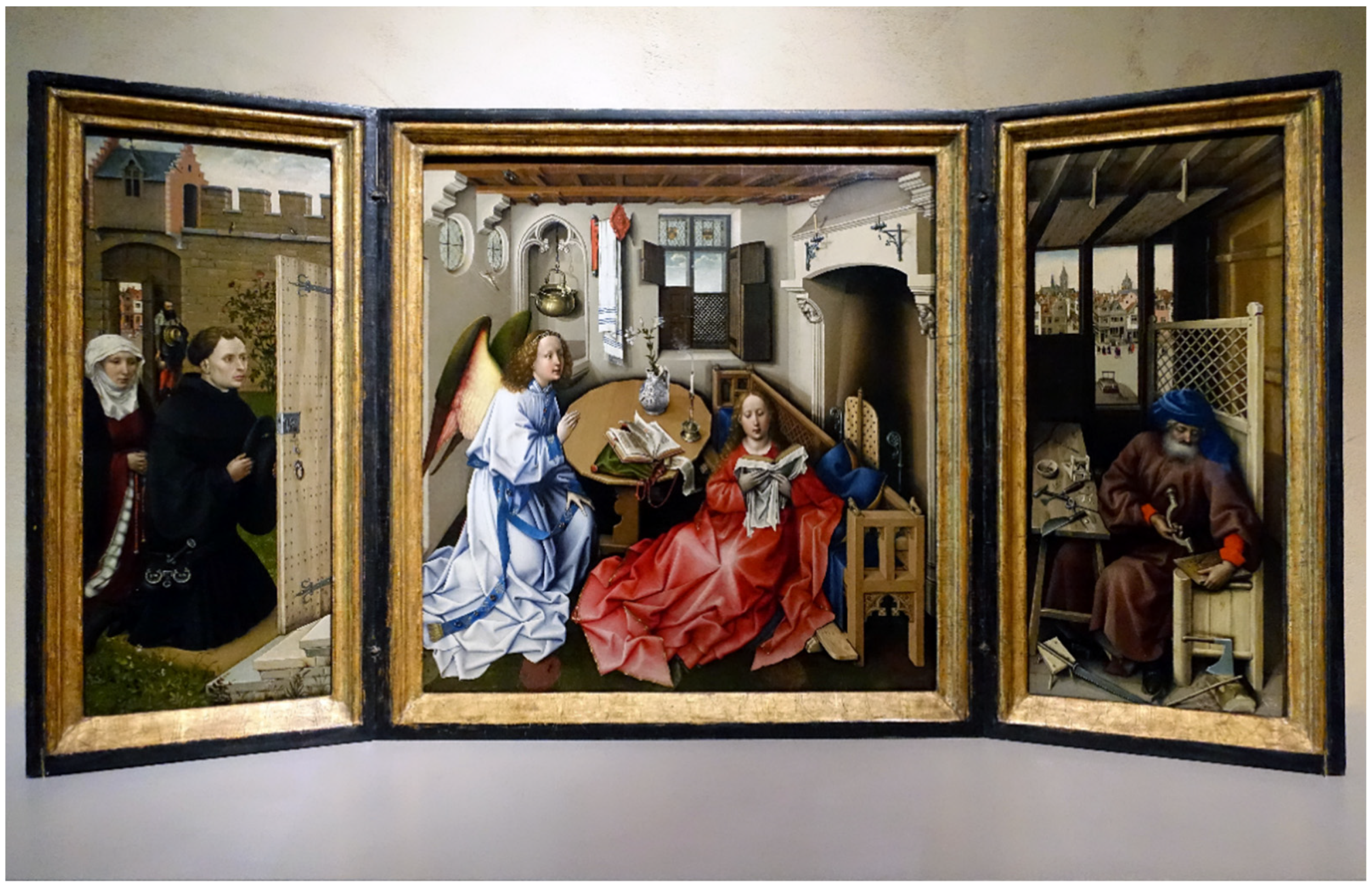

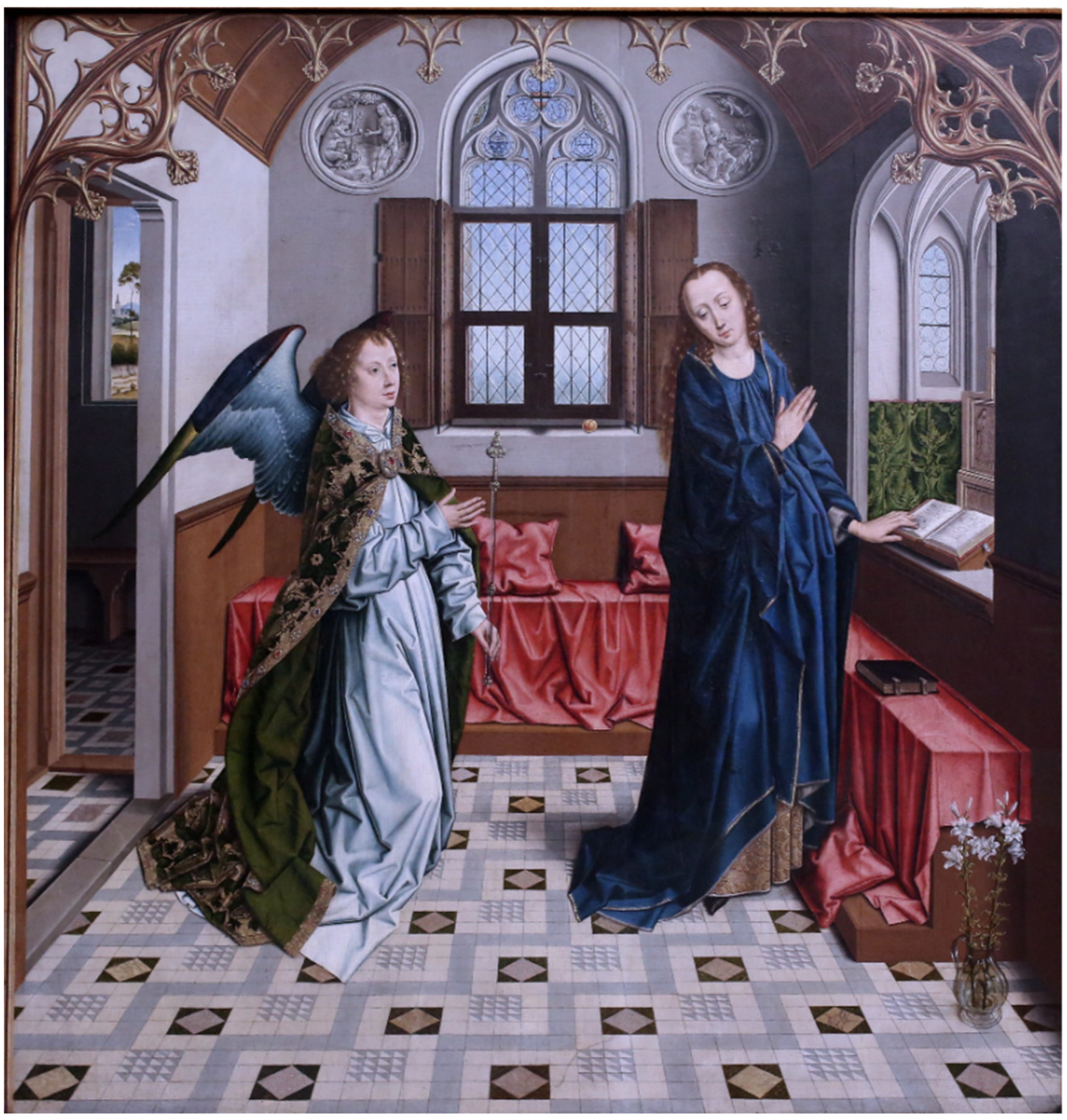

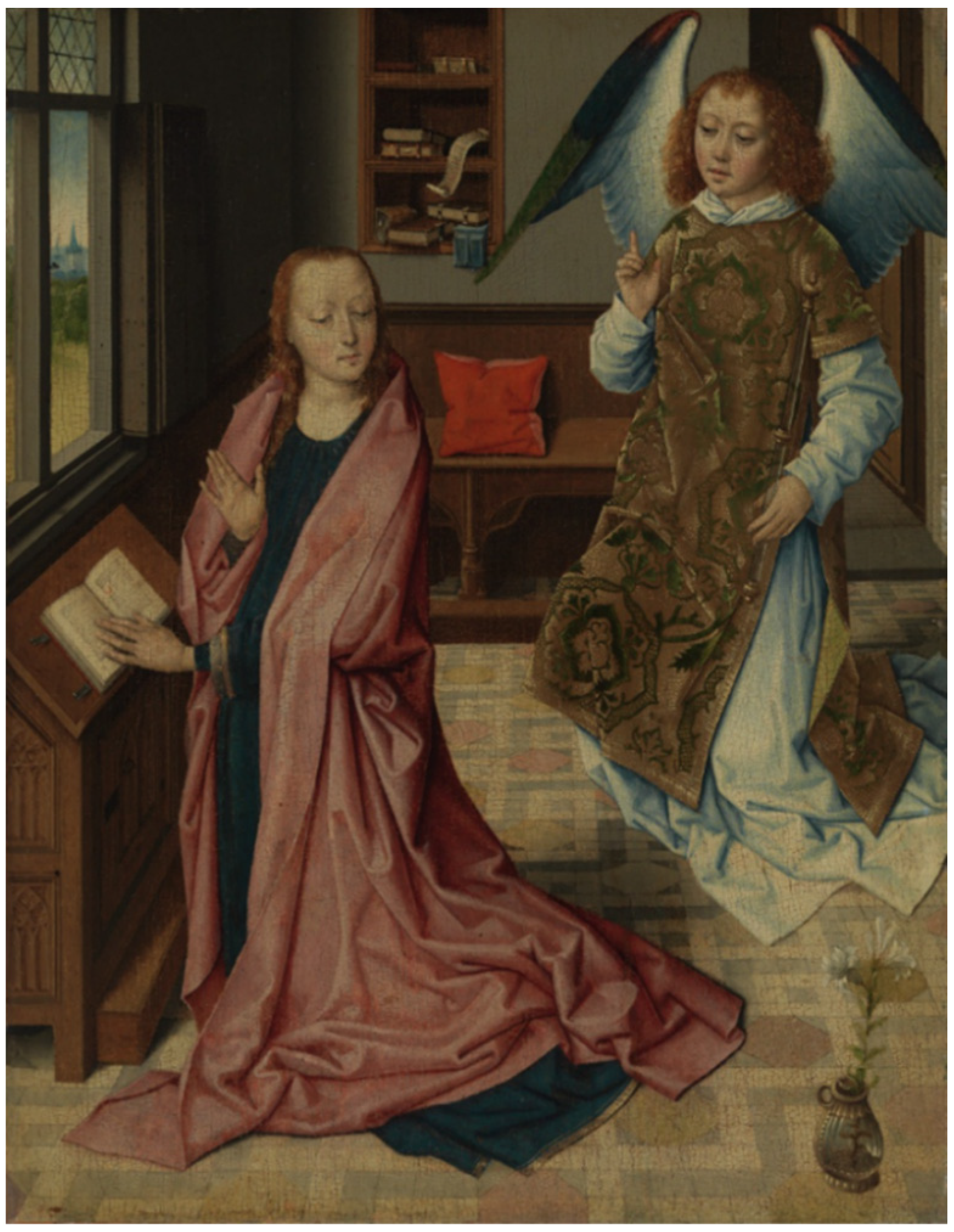
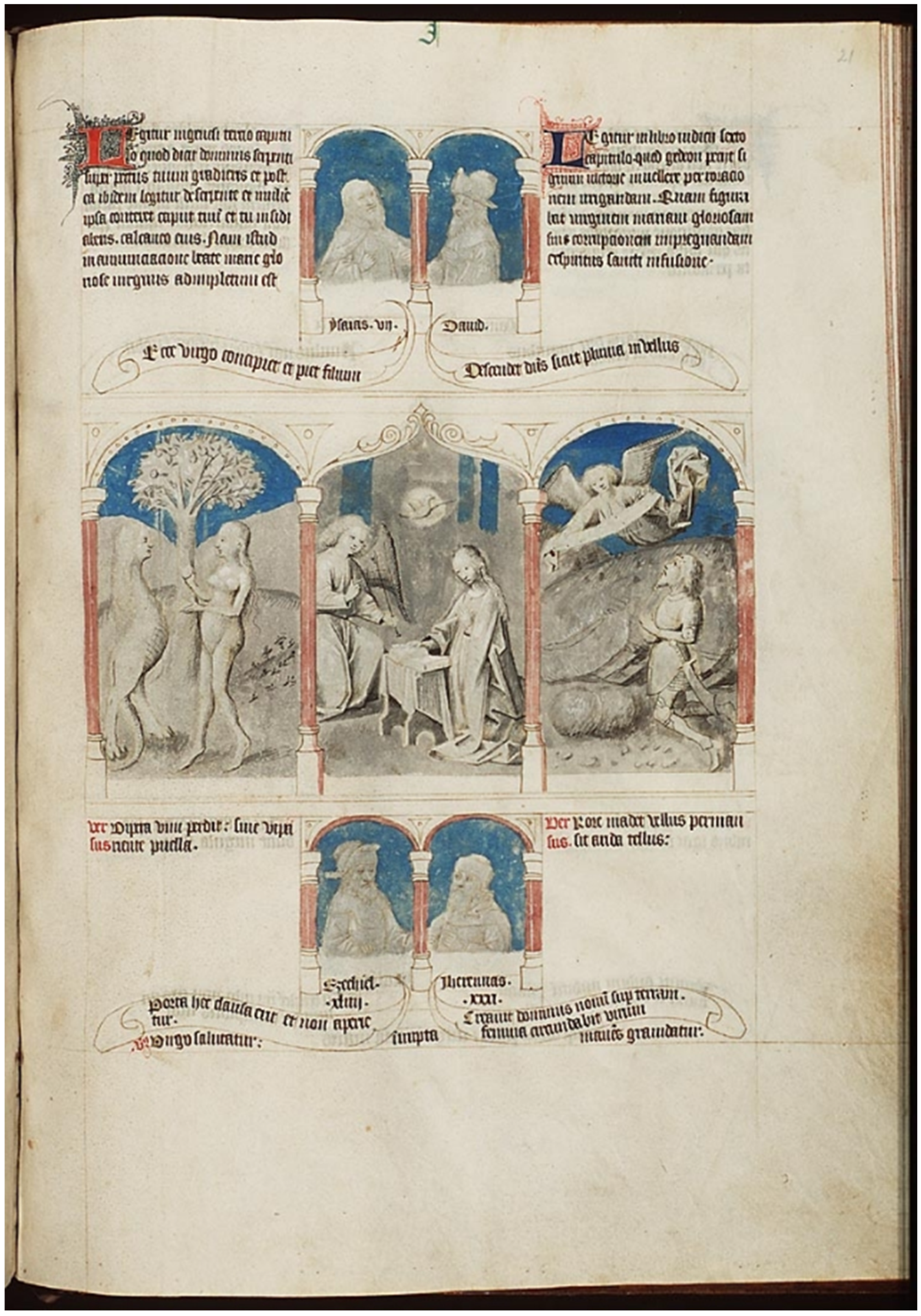
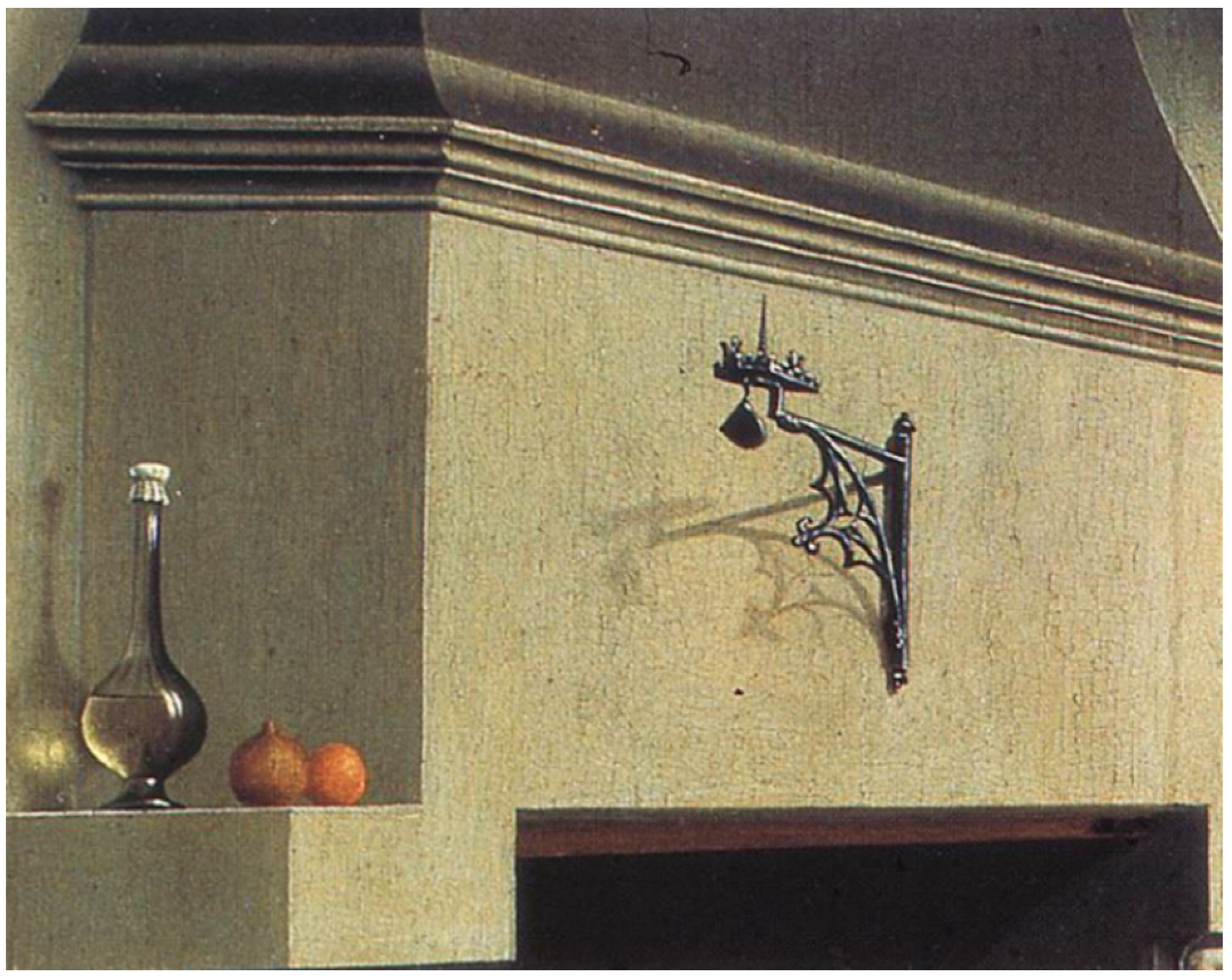

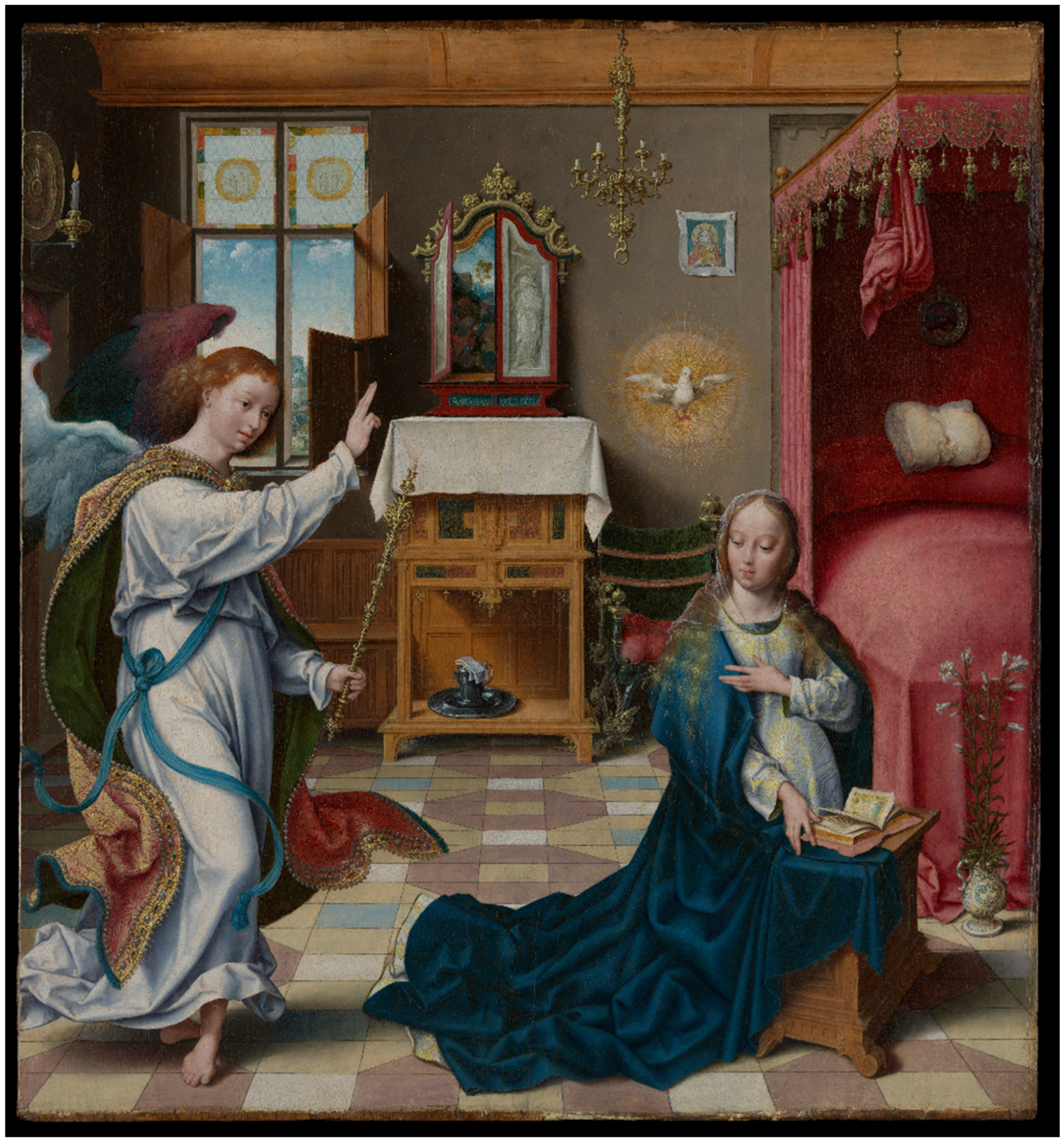
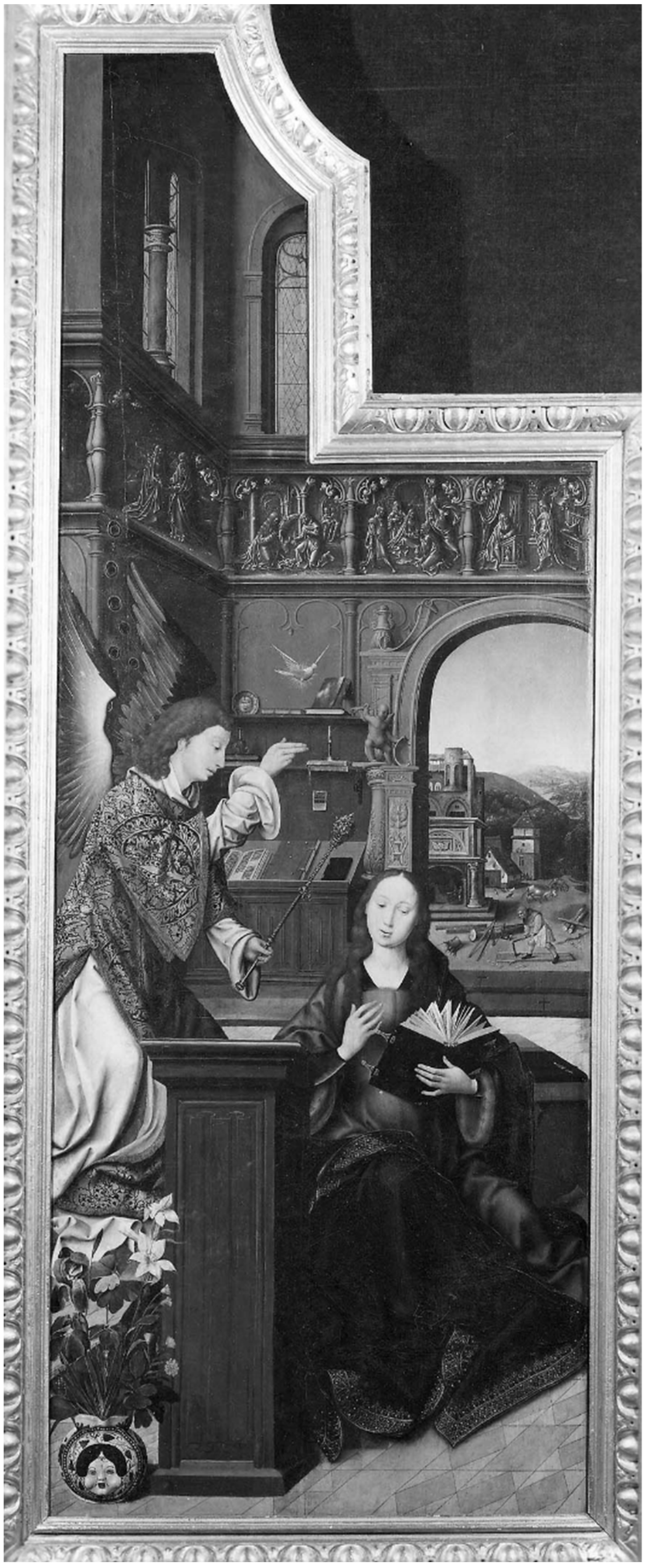
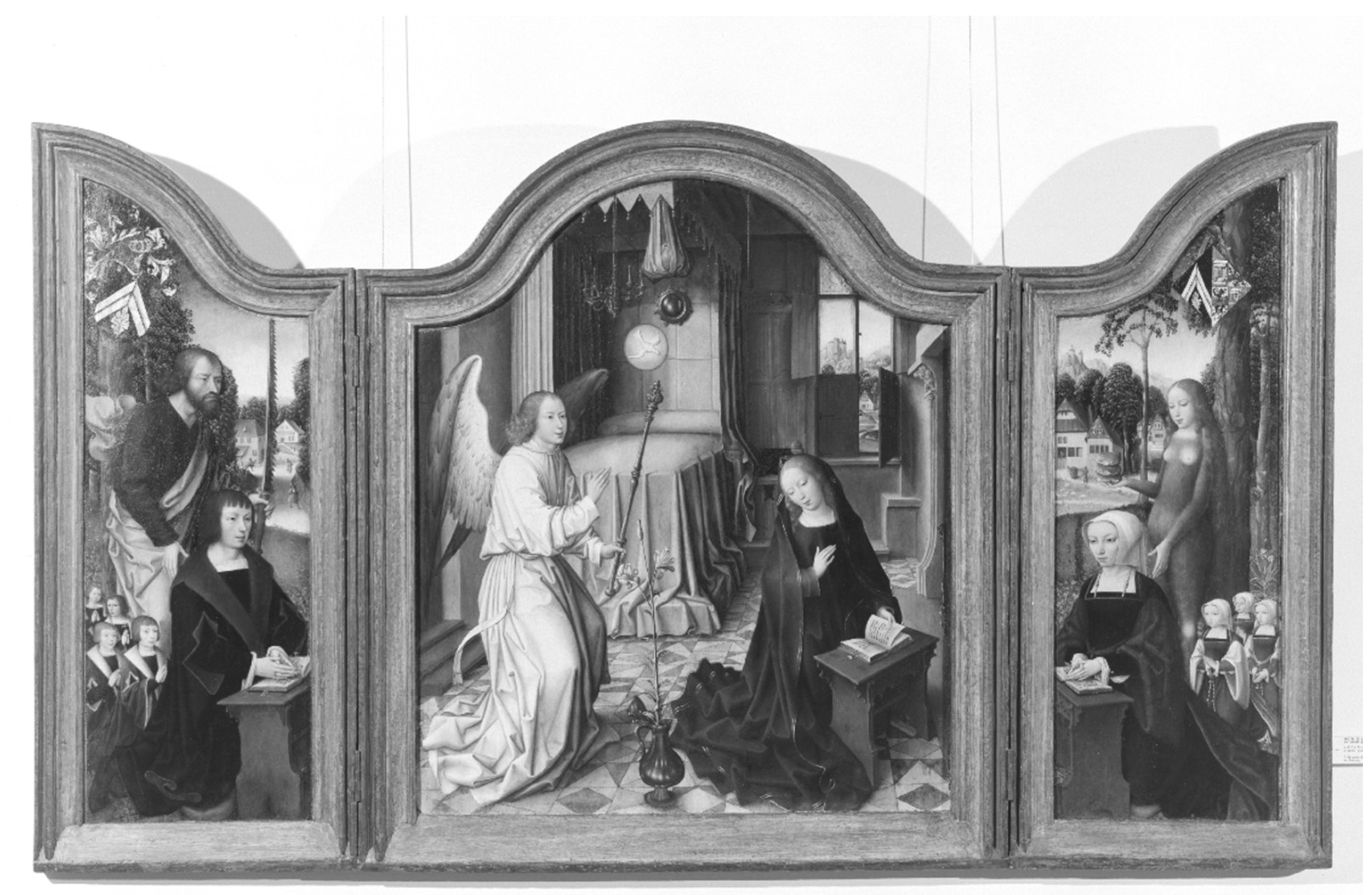
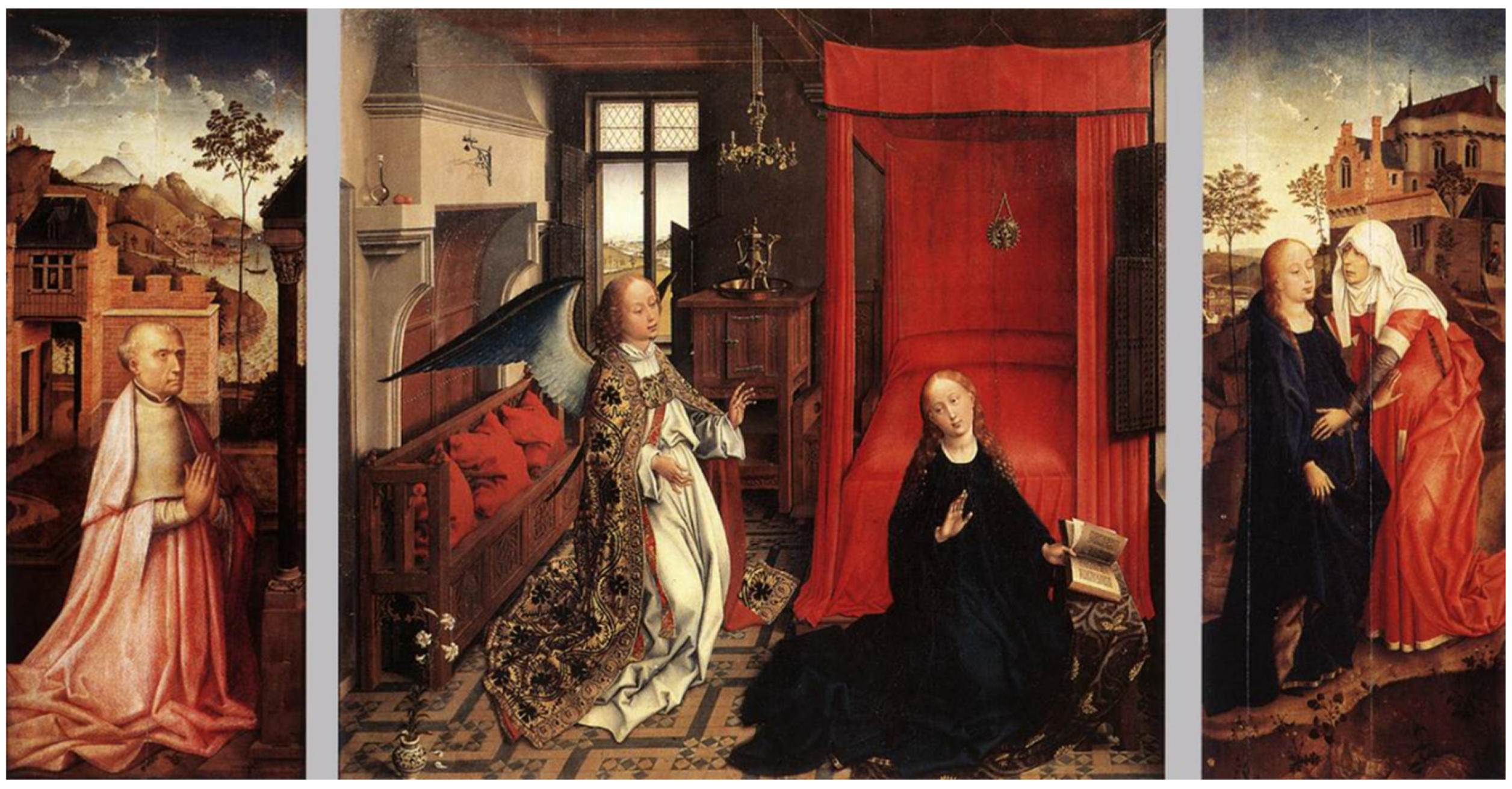
Publisher’s Note: MDPI stays neutral with regard to jurisdictional claims in published maps and institutional affiliations. |
© 2022 by the author. Licensee MDPI, Basel, Switzerland. This article is an open access article distributed under the terms and conditions of the Creative Commons Attribution (CC BY) license (https://creativecommons.org/licenses/by/4.0/).
Share and Cite
Pignarre-Altermatt, T.-O. What Approach to Flemish Annunciations? Arts 2022, 11, 33. https://doi.org/10.3390/arts11010033
Pignarre-Altermatt T-O. What Approach to Flemish Annunciations? Arts. 2022; 11(1):33. https://doi.org/10.3390/arts11010033
Chicago/Turabian StylePignarre-Altermatt, Thor-Oona. 2022. "What Approach to Flemish Annunciations?" Arts 11, no. 1: 33. https://doi.org/10.3390/arts11010033
APA StylePignarre-Altermatt, T.-O. (2022). What Approach to Flemish Annunciations? Arts, 11(1), 33. https://doi.org/10.3390/arts11010033





